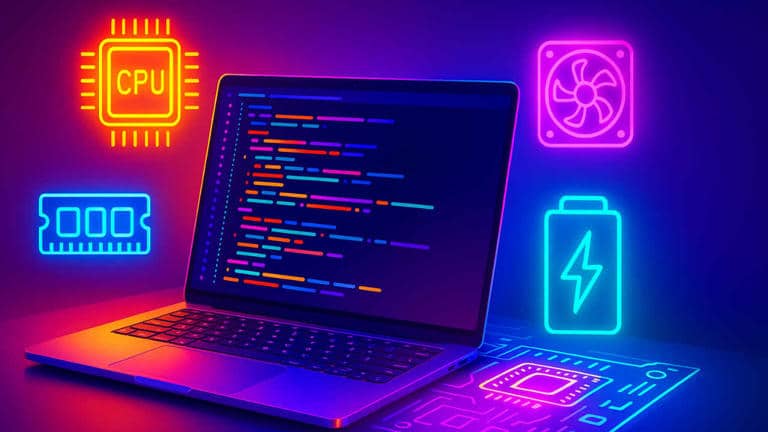Your complete guide to buying the perfect laptop for coding

💡 What to Look For in a Coding Laptop
1. Processor (CPU)
- For most coding tasks, a quad‑core CPU or higher is ideal. Intel Core i5/i7 (13th–14th gen) or AMD Ryzen 5/7 are solid picks. For macOS, the Apple M3/M4 chips offer excellent performance techradar.com+15freecodecamp.org+15hriztech.com+15.
- If you’re into heavy workloads like compiling large codebases, machine learning, game dev, or running VMs, a more powerful CPU or dedicated GPU could help diurnaltech.com+1reddit.com+1.
2. Memory (RAM)
- 16 GB is the practical minimum these days. Up to 32 GB+ for those using virtual machines, large IDEs, or ML workloads .
- If possible, choose a model with upgradeable RAM (e.g., Framework or ThinkPads).
3. Storage
- Prioritize fast NVMe SSDs—they significantly improve boot time, compilation, and project loading.
- A minimum of 512 GB is recommended; 1 TB+ if you handle big datasets, Docker images, or multimedia assets techradar.com+3en.wikipedia.org+3en.wikipedia.org+3.
4. Display
- Always go for at least a 1920×1080 (FHD) screen for sharp text and more workspace freecodecamp.org.
- Larger screens (15–17″) or high-resolution OLED/2.8 K panels reduce eye strain and boost productivity .
5. Keyboard & Build
- A comfortable keyboard with good key travel is essential—typing dozens of hours daily demands quality ergonomics windowscentral.com+15freecodecamp.org+15croma.com+15.
- Prefer sturdy builds (aluminum, magnesium) with solid cooling for longevity techradar.com+2reddit.com+2techmumy.com+2.
6. Battery Life
- Aim for ≥ 8 hours rated battery life. Real-world results for premium laptops (XPS, MacBook Pro/Air) often exceed this .
7. Operating System
- Windows/Linux: good flexibility; choose Linux‑friendly hardware or vendors like Dell/Lenovo.
- macOS: ideal for iOS/macOS developers, Unix-based workflows.
- Chromebook/ARM (e.g., Snapdragon X Elite): great battery life, lightweight coding techspark.in+2diurnaltech.com+2techmumy.com+2techrefreshing.com+1windowscentral.com+1.
🔝 Recommended Laptops for Developers
Here are several standout machines suited to different types of coding, available in India:
Portable OLED & great keyboard
Asus Zenbook 14″ OLED Intel Ultra Core
₹1,17,990
ASUS eshop IN + others
★★
4.5
Premium power‑house (Windows)
Dell XPS 16 (9640) Intel Ultra & RTX‑40
₹3,69,242.97
Dell India
★★
4.0
Lightweight AI‑efficient
Acer Swift Go 14 OLED (Core Ultra 7)
₹94,999
Acer Store – India
★★
4.7
Ask about this
ChatGPT chooses products independently. Learn more
🖥️ Asus Zenbook 14″ OLED
- Sleek 14″ OLED screen, great for front‑end and general coding.
- Likely includes 16 GB RAM, fast SSD.
- Portable and stylish—excellent balance of performance and mobility.
💪 Dell XPS 16 (9640)
- Packed with Intel Ultra CPU and RTX 40-series GPU—ideal for heavy-duty workloads.
- Large 16.3″ OLED/4K display; best-in-class build and thermal design.
- Great for full‑stack devs, data scientists, or game dev.
⚡ Acer Swift Go 14 OLED
- Lightweight (~1.2 kg), 14″ OLED screen, incredible efficiency with Intel Ultra 7.
- Up to 15–16 hours battery, ideal for remote and on‑the‑move programming.
- Priced under ₹1 lakh – strong value.
💻 Other Excellent Options
- Dell XPS 15/17: top Windows machines for coders; excellent builds and specs croma.com+2techmumy.com+2diurnaltech.com+2en.wikipedia.org+1hriztech.com+1croma.comanalyticsinsight.net+6spicanet.net+6croma.com+6.
- MacBook Pro 14/16 (M3/M4 Pro/Max): unmatched speed and battery life; best for Apple ecosystem developers .
- Lenovo ThinkPad X1 Carbon Gen 13: legendary keyboard, light, 2.8K display, long-lasting battery, Linux-friendly laptopmag.com+15hriztech.com+15en.wikipedia.org+15.
- HP Spectre x360 14/16: 2‑in‑1 flexibility, 120 Hz OLED touchscreen; ideal for front‑end dev/design reddit.com+9analyticsinsight.net+9diurnaltech.com+9.
- ASUS ROG Zephyrus G14/16: compact powerhouse with RTX GPUs, great for ML, GPU-heavy tasks analyticsinsight.net+2techrefreshing.com+2techmumy.com+2.
- Framework Laptop: ultra‑modular, upgradeable, developer-sustainable hriztech.com+5techradar.com+5diurnaltech.com+5.
🧭 Choosing Based on Your Workflow
| Your Use Case | Recommended Specs | Best Picks |
|---|---|---|
| Web/App dev (Node, React, backend) | 14″, 16 GB RAM, fast SSD | Zenbook, XPS 13/15, MacBook Air |
| Full‑stack + Docker/Vagrant | ≥ i7/Ultra, 32 GB RAM | XPS 16, ThinkPad P1, MacBook Pro |
| ML & AI workloads | RTX GPU or Apple Max | Zephyrus, XPS + RTX, MacBook Pro |
| Front‑end/design work | OLED touchscreen | Spectre x360, Swift Go OLED |
| Lightweight portability | 1.2 kg+, 14″, 12–16 hr battery | Swift Go, Zenbook, ThinkPad X1 Carbon |
✅ Final Tips Before You Buy
- RAM: Opt for at least 16 GB—32 GB if your budget allows.
- Storage: SSD ≥ 512 GB, NVMe for speed.
- Screen: FHD minimum; OLED or 2.8 K is a luxe upgrade.
- Keyboard: Try it in‑store first if possible.
- Ports/Connectivity: Thunderbolt/USB-C, some USB-A/HDMI to avoid dongles.
- OS Compatibility: Ensure your dev tools run well on Windows/Linux/macOS as needed.
- Longevity & Support: Prioritize service centers, warranty, repairability (e.g., Framework, ThinkPad).
✅ TL;DR
- Best overall Windows: Dell XPS 15/16—balanced power and display.
- Best macOS: MacBook Pro 14/16 (M3/M4) – unbeatable efficiency and longevity.
- Best ultraportable: Acer Swift Go 14, Asus Zenbook 14 – ideal for coding on the move.
- Best for heavy work: XPS 16 or Zephyrus + RTX – great for ML, game dev, multi‑VM setups.




